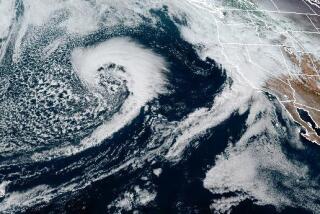
A nasty storm is brewing over the meteorological heart of Los Angeles.
A decision by government forecasters to relocate downtown L.A.’s official weather observation station from USC to Dodger Stadium is generating extreme heat and wind gusts from some local climate experts. They insist the move will cast fog on local efforts to document the effects of climate change.
“It contaminates the record,” said Jan Null, a veteran California meteorologist who runs the Golden Gate Weather Service. “It changes the ballgame.”
The station — a curious array of poles, metal boxes and shiny cylinders that weather wonks know affectionately as “KCQT” — is slated to move from USC to the Los Angeles Fire Department’s training center on the south side of the stadium in Elysian Park on Monday. The last time the key monitoring station moved was 25 years ago.
The National Weather Service insists the relocation is necessary to improve accuracy. The USC site is located about 10 miles from the Pacific Ocean, which can influence temperature, humidity and precipitation measurements, they say.
“The core of downtown Los Angeles is located farther inland from the coast and current site [at USC],” the agency said in a news release. “Gathering observations farther inland at the Frank Hotchkin Memorial Training Center is expected to better represent the weather and climate of downtown Los Angeles.”
Aggressive and impactful reporting on climate change, the environment, health and science.
The decision by the weather service to trade “Tommy Trojan” for “Dodger blue” may seem trivial to the average Angeleno, but Null and others say it’s occurring at exactly the worst time: A period when local climate records are continually being broken.
“We are living in a warming world and experiencing more extreme weather,” said Bill Patzert, a retired climatologist from NASA’s Jet Propulsion Laboratory in La Cañada Flintridge. “Climate scientists depend on precise weather data to forecast our changing climate. If we are careless with the data, our understanding of the future will be messy.”
The downtown observation station — one of several stations scattered across Los Angeles — sets the baseline for the city’s core. Its measurements are key to determining records for temperature, rainfall and more.
Even though the weather station’s new home is just four miles from its old USC location, critics say the difference is significant. Temperatures and rainfall can vary by several degrees or inches. For instance, average annual precipitation at USC measures 14.19 inches compared with 15.96 inches at the new site, a change of more than 10%, said Null, who once worked as a lead forecaster for the weather service.
Last month, the NWS reported that downtown L.A. had received 52.46 inches of rain over the last two water years, marking the area’s second-wettest back-to-back rainy seasons on record. Such comparisons could be compromised by the change, Null and other experts said.
“A couple of miles doesn’t sound like a big difference, but the numbers are going to be different,” said Daniel Swain, a climate scientist with UCLA. “It won’t be quite apples-to-apples.”
However, it’s not the first time the station has been moved.
The NWS has been tracking the temperature of downtown L.A. since 1877, making it one of the longest-running records in Southern California and the West. The majority of its readings were taken at sites near the Los Angeles Civic Center, including a site at the Los Angeles Department of Water and Power that operated from 1964 to 1999, before it moved to USC.

Subscribers get exclusive access to this story
We’re offering L.A. Times subscribers special access to our best journalism. Thank you for your support.
Explore more Subscriber Exclusive content.
Just six years after that move, downtown L.A. missed setting an all-time rain record by 0.93 of an inch, which might not have happened had the rain gauge still been located at the Civic Center, said Patzert, who co-authored a 2015 study documenting the difference between the two sites.
The study found that the 1999 move to USC led to a “significant change to both temperature and precipitation records at the new location in comparison to the old.”

Patzert worries another move will further complicate the nearly 150-year-long climate record for downtown, and said merging mixed data from so many locations will make the record even less viable moving forward.
“The real issue here is the long-term baseline on which we base our projections of global warming,” Patzert said. “You really shouldn’t be fiddling with it.”
He added that in addition to changes in topography, altitude and wind, readings can be skewed by the urban heat island effect — by which concrete, asphalt and other hard surfaces can add up to 7 degrees of warming to an immediate area.
The latest back-to-back water years have become the wettest on record for Los Angeles since the late 1800s, with more than 52 inches falling since October 2022. And officials say more is on the way.
It’s a concern shared by other local weather watchers, including William Reid, a climatologist who runs the blog Stormbruiser and has written about issues with the USC site in the past.
“The exposure of the equipment and the surrounding landscape — and whatever’s happening around it as far as urbanization and pavement and grass — has a large effect on temperature measurements,” Reid said. “I’m just hoping that the new place has a really good exposure, and there aren’t any really big buildings or trees blocking the wind flow through there.”
Subscriber Exclusive Alert
If you're an L.A. Times subscriber, you can sign up to get alerts about early or entirely exclusive content.
You may occasionally receive promotional content from the Los Angeles Times.
Reid said he has been documenting downtown L.A.’s high and low temperatures every day for more than 30 years. Though there are pros and cons to the relocation, he said the new site will likely be more representative of temperatures downtown.
“It’s really hard to get a real good siting in a place like L.A.,” he said. “Some places probably have a warm bias, and some places have maybe a cool bias, and that’s just how it goes. Nothing’s perfect in climatology.”

Indeed, while the latest change may interrupt the continuity of the last quarter century, it also marks a return to those more historical conditions, according to Ariel Cohen, meteorologist in charge at the NWS Los Angeles office.
“We’re going to have to think about this long-term,” Cohen said. “We’re having the opportunity for better observational records in the future.”
He said the decision also dovetails with a 2000 study from NWS forecaster David Bruno that helped the agency better understand the way micro-climates in the greater Los Angeles area can deliver different conditions across relatively small distances.
“Between that publication 24 years ago and our observations over time, it’s clear that our weather and climate records are not quite representative of what’s going on in downtown L.A. and where the site was previously located,” Cohen said.
Swain, of UCLA, said ideally the agency would add a new station and keep the old one. But even stations that are never moved can see shifts over time as their surrounding landscape or built environment changes, and many single stations are imperfect in some way, he said.
“Does this overturn climate science or make it impossible to say whether L.A. is getting warmer or drier or wetter? No — it just means it’ll just be less easy to use this specific site to determine record-breaking temperatures or rainfall at that particular location, because now we don’t have a long-term record in the new location and it’ll be starting from scratch,” he said.
The proposed Dodger Stadium gondola goes before the Metro board as the fight for community support intensifies at William Mead Homes, a public housing project on the edge of Chinatown.
Science might not have been the only factor in the decision to move, however. It may have also involved real estate. The university granted the weather service use of the land at no charge, The Times reported in 1999.
In a statement about the upcoming move, university officials said they weighed concerns about the location with pending upgrades to campus facilities.
“For 25 years, the university has hosted a weather station for the National Weather Service in Los Angeles,” the statement read. “USC leaders were made aware of concerns over the years about the accuracy of the station’s readings based on its campus location, which were raised by multiple federal scientists in white papers, reports and studies. Recently, as we began renovating our athletics facilities near the station, we discussed their concerns about its location and if now was a good time to relocate.”
A university spokeswoman confirmed that there are several construction projects in the works near the site, including upgrades to Dedeaux Field.
“We are grateful for the National Weather Service’s partnership and wish them well as they continue to provide a needed service to all Angelenos,” the statement said.

Dodger Stadium is also the site of a hotly contested proposal for an aerial gondola project backed by former team owner Frank McCourt. Plans for the gondola — which would land in a parking lot not far from the fire training center — have divided the neighborhood.
Patzert said the weather station’s move could also benefit some sports fans on that side of town. Research has found that warmer weather may contribute to more home runs, so perhaps locating the site steps from the field will “help the gambling people,” he joked.
Cohen, of the weather service, said the new site will also help fill a “data void” in the area around Elysian Park, which is susceptible to heavy brush growth and the spread of wildfires. Having an observation station near Dodger Stadium will allow for better fire weather forecasting in that area, he said.
The new site, which will go by the identifier FHMC1 for the Frank Hotchkins Memorial Center, will be fenced off in an area by the parking lot, he said. It will host the entire suite of observational equipment including thermometers, rain gauges, wind sensors and humidity meters.
Cohen added that his team is “excited about going forward” and about having better cohesion with the original historical records.
“It allows for the long-term continuity to be reinforced,” Cohen said, “while simultaneously being more representative of the conditions in downtown L.A.”









